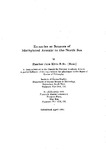Estuaries as Sources of Methylated Arsenic to the North Sea
| dc.contributor.author | Kitts, Heather Jane | |
| dc.contributor.other | School of Geography, Earth and Environmental Sciences | en_US |
| dc.date.accessioned | 2013-09-19T09:53:50Z | |
| dc.date.available | 2013-09-19T09:53:50Z | |
| dc.date.issued | 1991 | |
| dc.identifier | NOT AVAILABLE | en_US |
| dc.identifier.uri | http://hdl.handle.net/10026.1/1867 | |
| dc.description.abstract |
Analytical techniques were developed for the detection of inorganic arsenic (As(III) and As(V)), monomethylarsenic (MMA) and dimethylarsenic (DMA) in water, pore waters, suspended particles and bed sediments of the Humber Estuary, Thames Estuary and the southern North Sea. Dissolved inorganic As in the Humber Estuary showed removal in the mouth of the estuary in association with an Fe-rich outfall. Intertidal sediments and suspended particles had elevated inorganic As concentrations in the vicinity of the As-rich outfall located in the low salinity zone. Particulate As had a distinct concentration gradient away from the estuary mouth, indicating the transport of As out of the estuary. The presence of MMA and DMA in the water column was attributed to the methylation of inorganic As by marine phytoplankton and was not detected when the seawater temperatures were below about 10° C DMA concentrations were higher than MMA. The Humber and the Thames Estuaries both had sources of inorganic As, but As methylation within the estuaries was not significant. MMA and DMA in the estuarine plumes and the North Sea showed strong seasonality, with concentrations below detection in winter, and maximum concentrations in late summer when the methylated As was 21% of the total As in the Humber and Thames Plumes. The concentrations of MMA and DMA in the early autumn (32% of the total dissolved As) were highest off the Dutch coast where the water temperatures were up to 18° C. There were no significant correlations between the methylated As and inorganic As, temperature, chlorophyll a nor phosphate. A water sample from a developing spring bloom was incubated and showed the removal of inorganic As at a rate of 0.04ugAs/l/day, but there was no subsequent increase in the dissolved organic species, indicating a delay interval between peak primary productivity and the release of MMA and DMA. Inorganic As was detected in the porewaters of the Humber and Thames Plumes. In late summer, MMA and DMA were found at equivalent concentrations in all the Humber Plume porewaters. Flux calculations indicated that the diffusion of inorganic As, MMA and DMA from the sediments into the water column was insignificant, largely as a result of low sediment porosity. However, a resuspension event caused a detectable increase in inorganic As at the bottom of the water column. The importance of this work to the development of the 3-D hydrodynamic model of the North Sea is discussed. | en_US |
| dc.description.sponsorship | Plymouth Marine Laboratory, Prospect Place, West Hoe, Plymouth PL1 3DH | en_US |
| dc.language.iso | en | en_US |
| dc.publisher | University of Plymouth | en_US |
| dc.title | Estuaries as Sources of Methylated Arsenic to the North Sea | en_US |
| dc.type | Thesis | |
| plymouth.version | Full version | en_US |
| dc.identifier.doi | http://dx.doi.org/10.24382/3238 | |
| dc.identifier.doi | http://dx.doi.org/10.24382/3238 |
Files in this item
This item appears in the following Collection(s)
-
01 Research Theses Main Collection
Research Theses Main


